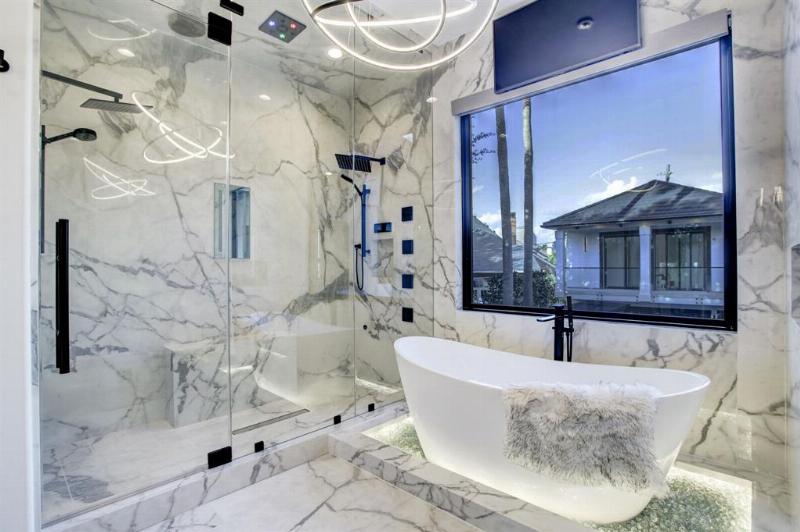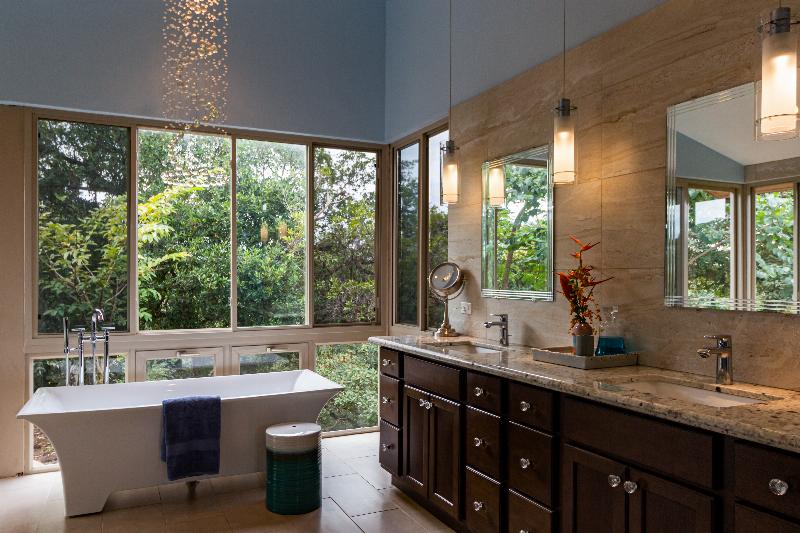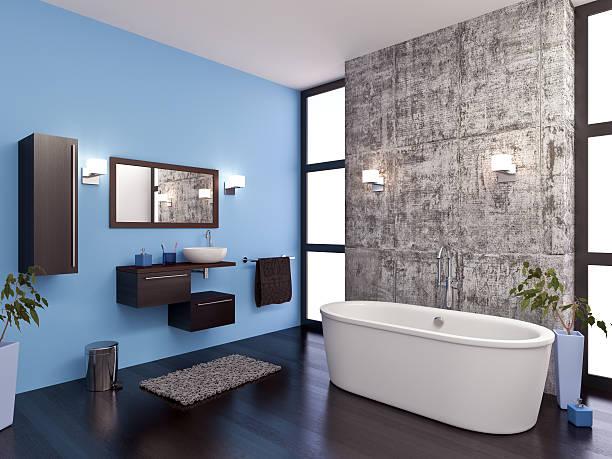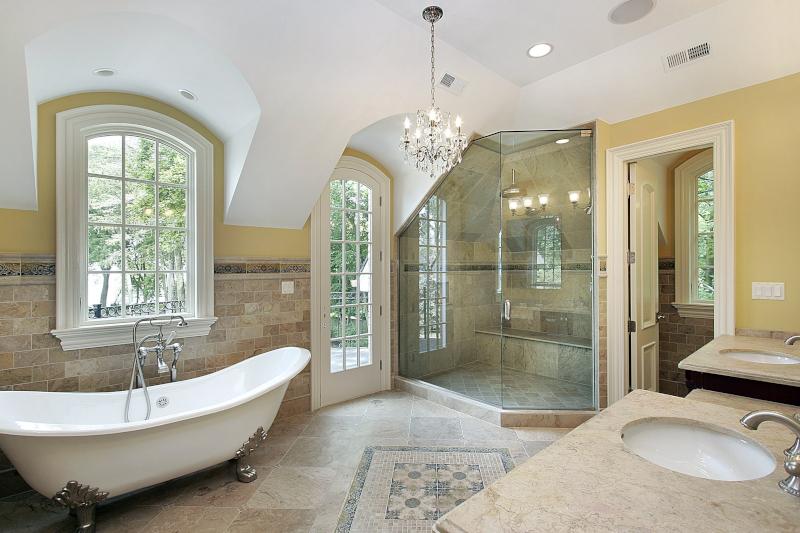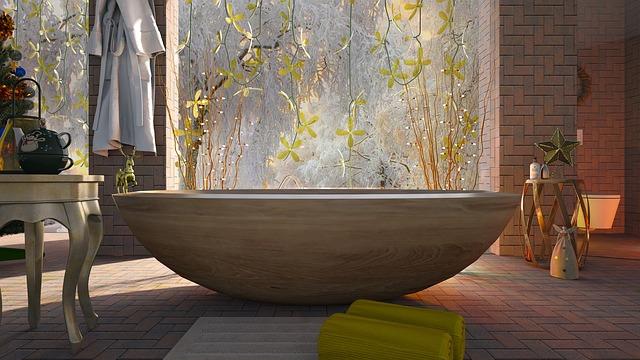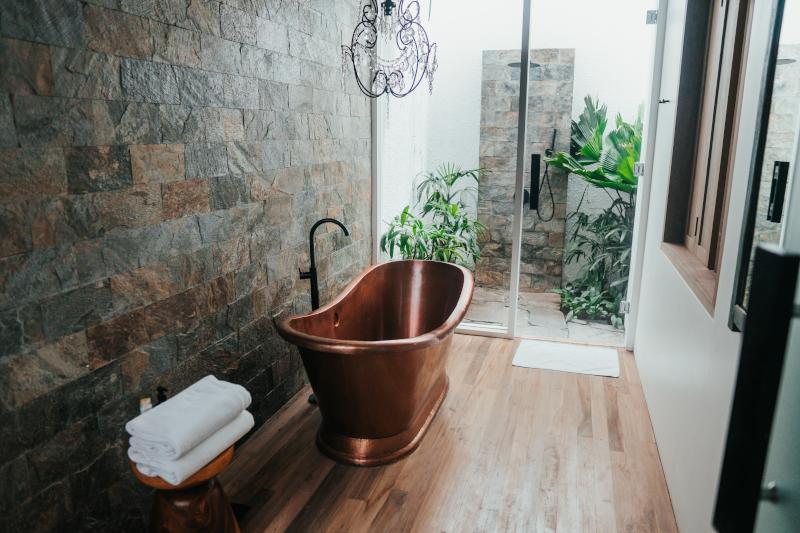What is the best material for a bathtub?
We understand how stressful it may be to shop for a fixture as significant and lasting as a new bathtub. Knowing the pros and drawbacks of the materials used in a tub is one of the greatest methods to decide if it’s good for you.
Material influences aesthetics, durability, heat retention, and other factors. It is thus an important consideration in your long-term investment. Choosing the bathtub material that would best fit your bathing needs is important.
Consider another crucial element before making your decision.
Let’s look at some of the more prevalent bathtub materials.
|
Porcelain Enameled Steel |
Fiberglass (FRP) |
|---|---|
|
Acrylic |
Enameled Cast Iron |
|
Cast Polymer (Cultured Marble, Granite, or Onyx) |
Solid-surface materials |
|
Ceramic tile |
Stone |
|
Copper |
Wood |
|
Stone resin |
|
The tubs are wrapped up with a gel-coat wrap-up.
Read Also: How to Convert Powder Room to Full Bath
Porcelain Enamel steel
Steel bathtubs, also known as porcelain on steel tubs or enameled steel tubs. They are made from a stamped steel shell that is then covered with heat-fused porcelain enamel.
The enamel coating allows the bathtub surface to be cleaned while remaining lustrous. It also contributes to the tub’s scratch resistance. Steel tubs keep your water hot for a long time since the material is a good heat conductor.
Here are some of its advantages and disadvantages.
|
Pros |
Cons |
|---|---|
|
Can be cheap |
When things are dropped, the surface might chip. |
|
Lightweight in comparison to others |
Rust may form on even the tiniest chip |
|
Standard sizes are available (60 x 30 inches) |
Color and form possibilities are limited. |
|
Durable |
If not insulated, it may be rather loud. |
|
Simple to clean |
Loses heat fast |
Acrylic
Acrylic tubs are a popular choice. This is because of its adaptability, durability, variety of possibilities, and inexpensive cost. This tub construction is of vacuum-formed acrylic sheets reinforced with fiberglass. Acrylic tubs are lightweight and simple to set up.
This is a kind of plastic with a high-gloss surface and good durability. Solid acrylic is a mid-priced, long-lasting alternative to fiberglass. Its scuffs are less obvious since the color is consistent all the way through.
It is popular for shaped whirlpools with molded armrests and other decorations. since it is easy to mold into designs. It’s also lightweight, which is vital in huge tubs where structural parts are damaged.
Here are some of its advantages and disadvantages
|
Advantages |
disadvantages |
|---|---|
|
Lightweight |
Using abrasive cleaning tools to clean the surface, it may scrape. |
|
Affordable |
Strengthening stress areas is a must during installation |
|
There are several colors, shapes, and sizes available. |
Acrylic costs more than fiberglass. |
|
Durable |
They are not crack resistant |
|
Surface with no pores |
When you stand on it, it may flex. |
|
Repairable surface |
|
Cast Polymer (Cultured Marble, Granite, or Onyx)
Cast polymer bath materials incorporate common stone and strong surface materials. They are made by molding together minerals, polymeric materials, and tars. These make a strong fabric comparable to solid-surface countertops (such as Corian).
These cast polymer items offer clean lines, concordant styling, and a nonporous surface. It stands to buildup, recolor, and wipes clean with negligible exertion. It complements an ever-broadening run of building and brightening styles. Doing this from conventional plans to the foremost modern.
All three materials are accessible in an ever-changing palette of colors.
It has the following pros and cons
|
Pros |
Cons |
|---|---|
|
Pricing is modest |
Brittleness is possible. |
|
There are several color possibilities. |
Gel coat wear can cause irreparable fissures. |
|
Surface scratches can be removed by buffing. |
|
|
Simple to clean |
|
|
Mildew and stain resistance |
|
Enameled Cast Iron
A classic bath fabric, enameled cast press is durable—and overwhelming. The tub is made of molded press coated with a porcelain finish. A cast-iron tub maybe a higher-end alternative, but it is a speculation that will be final. The as it were noteworthy drawback (and a genuine one) is the weight.
A cast-iron tub can be very troublesome to introduce. This is because it is so overwhelming and may need auxiliary fortification of the floor.
Pro tip takeaway: Because of its endurance, many professionals favor enameled cast iron. When damaged, this material may be refinished, increasing its longevity even further.
|
Pros |
cons |
|---|---|
|
Long-lasting |
Heavy |
|
Thick enamel is scratch and chip-resistant. |
|
|
Resurfacing is possible. |
|
|
Outstanding heat retention |
|
|
There are several color options available. |
|
Solid-surface materials
Solid-surface bathtubs are made of synthetic, polymeric materials. They come in a variety of design styles. They are long-lasting and efficient, but they are also hefty and rather costly.
Solid-surface materials are newcomers to the bath industry
The following are its pros and cons
|
Pros |
Cons |
|---|---|
|
They’re strong |
They’re quite overpowering |
|
They keep you warm |
They need a significant lead time to induce |
|
They come in a variety of modest, natural-looking hues |
Expensive |
|
The wrap can be mended if necessary. |
|
|
Fabricated in an assortment of shapes and sizes. |
|
Stone resin
Stone resin is a substance that is used to simulate the appearance of genuine stone. This is one of the most effective bathtub materials. In fact, I’m considering it for my new installation.
It has a luxurious appearance. It’s composed of pulverized real stone and polymer resin that looks like stone.
These tubs are overwhelming and need uncommon basic surroundings to bolster their weight.
As you’d envision, with any of these genuine one-of-a-kind pieces, you get a magnificent “wow factor,”. This comes with a lovely tall cost tag.
Pros and cons of a stone resin tub include:
|
Pros |
Cons |
|---|---|
|
Color does not blur with rehashed water use. |
Stone resin is more expensive than acrylic or fiberglass. |
|
The fabric is non-porous meaning it does not keep water and holds water warm well. |
|
|
It has a long life expectancy, enduring for very few times without the need for steady repair. |
|
|
When it should be disposed of, stone tar is 100% recyclable. |
|
|
Stone gum is also viewed as a more elegant bath material |
|
|
The fabric itself is very strong and able to resist an overwhelming sum of discipline. |
|
|
Cleaning is basic and simple. |
|
|
Most stains and buildup will wash absent with basic warm water. |
|
|
Stone Gum is the leading bath fabric generally for cost and quality. |
|
Wood
A handcrafted bathtub built from several sorts of wood.
You can moreover custom-order a bath made from teak and certain other woods.
The case of wood and a few of the stones requires a part of support in order to hold the tub’s unique excellence. (Inman 2018)
Here are some pros and cons of a wood tub
|
Pros |
cons |
|---|---|
|
Attractive has a true, natural vibe. |
Comes at a high cost. |
|
Wood is easy to work with. |
Not durable |
|
Depending on your preferences, wooden bathtubs can take any shape or size. |
Considerations, like space and structure, must be made in your home to accommodate a wooden tub. |
|
They bring a feeling of elegance to your bath time. |
Monthly maintenance is required to maintain its durability. |
|
|
Overuse will wash away the resistant sealant, hastening the rotting process. |
|
|
Underuse will dry up the wood, hastening the rotting process. |
Copper
Copper bathtubs are created by hammering together many sheets of pure copper.
|
Pros |
cons |
|---|---|
|
Like a cast iron tub but with a more appealing appearance. |
This tub, like the cast iron, is also rather hefty. |
|
A copper tub is both beautiful and durable. |
It is also more unusual or difficult to locate. |
|
It is resistant to scratches and another chipping that may occur. |
It is the most expensive bathtub on the market. |
|
Easy to clean |
|
Stone
Normal stone materials, counting stone, marble, onyx, travertine, basalt, sandstone, and other materials.
You’ll be able to custom make a bathtub from an assortment
|
Pros |
Cons |
|---|---|
|
Longevity |
Expensive |
|
Heavy heat retention – may need floor support |
|
|
Chip resistance Luxury appearance |
|
Pro tip takeaway: The weight of your bathtub is related to the cost in more ways than one. For starters, heavier bathtub materials are more expensive.
Ceramic tile
These bathtubs are built of a variety of ceramic tiles. You may choose tiles of varying quality based on your budget.
This material provides by far the greatest size, shape, and style choices.
Unfortunately, it also needs more upkeep. You must control the grout that holds the tiles in place. Furthermore, the tub’s surface will be uneven. This may feel strange on your naked skin.
|
Pros |
Cons |
|---|---|
|
Design variation |
Installation is difficult. |
|
Can be inexpensive |
A lot of upkeep |
|
|
It can be unpleasant. |
Are You Ready to select the Material For your Bathtub?
If you need help selecting the ideal bathtub for your dream bathroom, don’t hesitate. contact Smart Remodeling LLC now! We can assist you in determining which bathtub material is ideal for you. We also provide free consultations. It is our pleasure to assist you in selecting the greatest feature of your new bathroom! Call our 24-hour repair hotline. 832 800 8889 or contact sales@smartremodelingllc.com.

